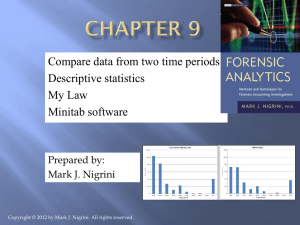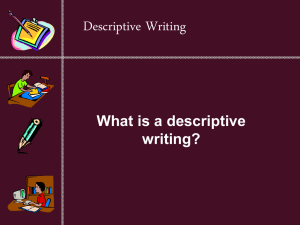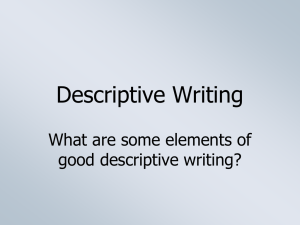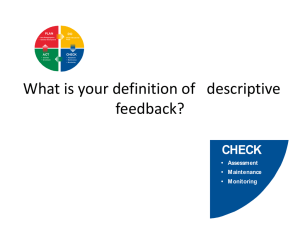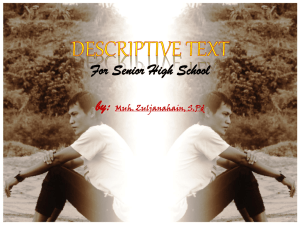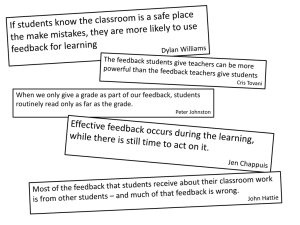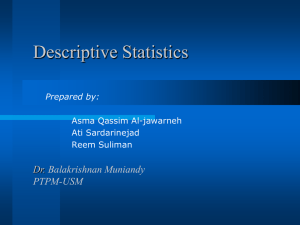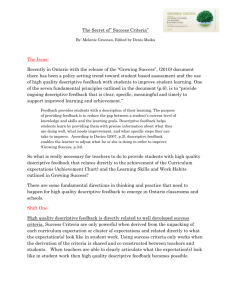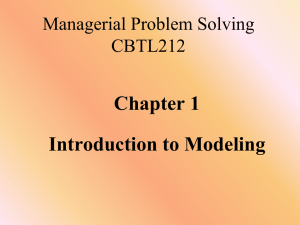Feedback…..
advertisement
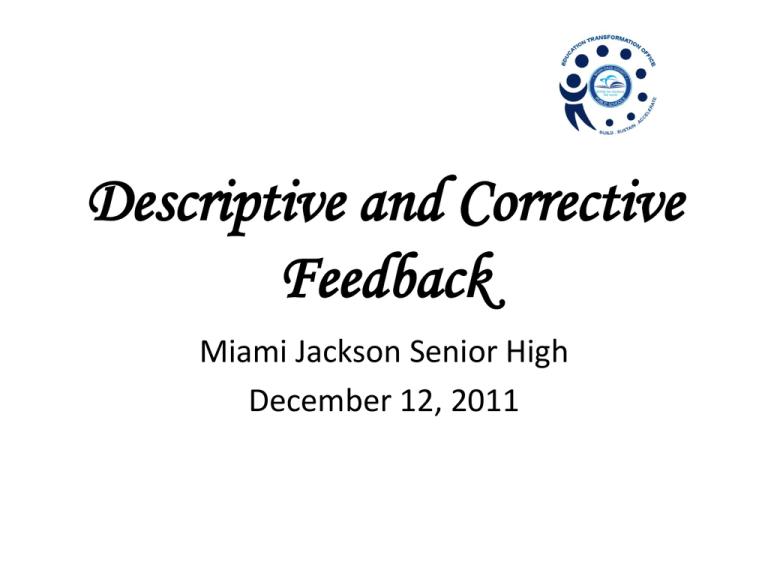
Descriptive and Corrective Feedback Miami Jackson Senior High December 12, 2011 How can we provide students with feedback on their work that will start them on an “upward spiral?” Feedback FOR Learning has 3 major components: • Accurate Information • Descriptive Feedback • Student Involvement 4/12/2015 2 What is descriptive feedback? Feedback….. • Focuses on providing information to the student with the goal of improving what is being addressed. • Allows the student to adjust and revise their thinking. • It is conversational, less formal and is not judgmental or evaluative. 4/12/2015 3 Effective Descriptive Feedback • Should be specific to how to improve performance • Should be timely • Should be relevant to the student and their goals • Should be clear and concise 4/12/2015 4 Feedback CONTENT can be EFFECTIVE or INEFFECTIVE: • Ineffective Descriptive Feedback – Irrelevant – General – Delayed – Overwhelming 4/12/2015 5 Utilizing Descriptive Feedback in Science: • • • • • • • Science notebooks Homework assignments Science Projects (Ongoing) Reports Research Papers Performance Task Items Presentations 4/12/2015 6 Effective vs. Ineffective? you be the judge 4/12/2015 7 Descriptive Feedback Sample 1: “I love the chart that starts with trees and ends up at the recycling plant (instead of back at more trees). It follows the relevant section of your report and illustrates the complete cycle so clearly! How did you come up with that idea? “ Focus Clarity Specificity Tone 4/12/2015 8 Descriptive Feedback Sample 2: “Your report was the shortest one in the class. You didn’t put enough in it. “ Focus Clarity Specificity Tone 4/12/2015 9 Effective Descriptive Feedback addresses both cognitive and motivational factors. • Cognitive factors: Corrective feedback gives specific information students can use. It focuses on their strengths and ways to improve. • Motivational factors: Once the students feel they understand what to do and why, a sense of control is developed. 4/12/2015 10 Effectiveness of providing feedback Category Average Effect Size % Gain # of Studies Identifying Similarities & Differences 1.61 45 31 Summarizing & Note-Taking 1.00 34 179 Reinforcing Effort & Providing Recognition .80 29 21 Homework & Practice .77 28 134 Nonlinguistic Representation .75 27 246 Cooperative Learning .73 27 122 Providing Feedback .61 23 408 Generating & Testing Hypotheses .61 23 63 Cues, Questions, & Advance Organizers .59 22 1251 4/12/2015 11 How will you know if your feedback was effective? • Your students learn; their work improves. • Your students become more motivated; they believe they can learn, want to learn and take more control over their own learning. • Your classroom becomes a place where feedback is valued and viewed as productive. 4/12/2015 13 So, how can we give descriptive feedback that is informational as well as motivational? 4/12/2015 14 Descriptive Feedback Strategies 4/12/2015 15 Descriptive Feedback Strategy #1 Model both giving and using feedback: • Use think-aloud activities so students see how revisions are made and why • Create a classroom environment where feedback is expected and “mistakes” are recognized as opportunities for learning • Provide feedback PRIOR to providing the grade 4/12/2015 16 Descriptive Feedback Strategy #2 Be clear about the learning target and the criteria for good work: • Explain to the student why an assignment is given; set a relevant purpose for the work • Make directions clear • Utilize student friendly rubrics • Have students develop their own rubrics or translate yours into student friendly language if appropriate • Design lessons that incorporate using the rubrics as students work 4/12/2015 17 Descriptive Feedback Strategy #3 • Teach students self and peer assessment skills. • Teach students to use tools to help determine and track their own data and feedback • Develop self-regulation skills necessary for using any feedback 4/12/2015 18 Students can use tools to help determine and track their own data and feedback. HOW CLOSE AM I TO MY TARGET? SUBJECT: 100% Date: Date: 80% 80% 100% 100% Date: 80% 100% 80% 4/12/2015 100% Date: 80% Date: 100% Date: 80% 19 Descriptive Feedback Strategy #4 Design lessons in which students use feedback on previous work to produce better work: • Provide opportunities to redo assignments • Give new but similar assignments for the same learning targets • Give opportunities for students to make the connections between the feedback they received and the improvement of their work 4/12/2015 21 Descriptive Feedback Starter Stems 4/12/2015 22 PDCA Inst ruct ional Cycle PLAN • Data Disaggregation • Calendar Development ACT DO • Direct Instructional Focus CHECK • Tutorials • Assessment • Enrichment • Maintenance APPLICATION • Monitoring Let’s review some student work: PDCA Inst ruct ional Cycle • Review the item sample, sample answer, student response and provide feedback . PLAN DO • Compare your feedback to that of the State. • Data Disaggregation • Calendar Development ACT • Direct Instructional Focus CHECK • Tutorials • Assessment • Enrichment • M aintenance • M onitoring 4/12/2015 23 4/12/2015 24 Activity: • Look at the student sample. • What type of corrective feedback would you give this student so that they can improve their response. 4/12/2015 25 The State’s Descriptive Feedback Did your Descriptive feedback address these weaknesses? 4/12/2015 26 Finding/Creating Rubrics: http://rubistar.4teachers.org 4/12/2015 27
